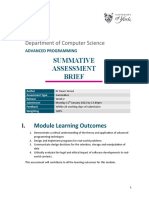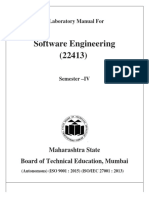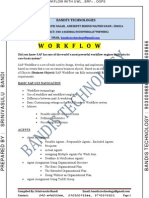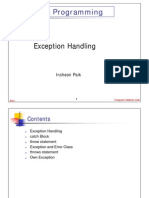Functional programing with java_Lab (1)
Uploaded by
vishalbhateriaFunctional programing with java_Lab (1)
Uploaded by
vishalbhateriaSN 22-CSP- Course Name: Functional L T P S C CH Course Type
226/22ITP-226 Programming with Java LAB
7. Course Coordinator: Ritu 0 0 2 2
PRE-REQUISITE --Java Programming
CO-REQUISITE --
ANTI-REQUISITE --
a. Course Objectives
1. Master functional programming concepts in Java through hands-on practice.
2. Efficiently transform data using Stream API and advanced operations.
3. Implement concurrent Java applications using functional techniques.
b. Course Outcomes
CO1 Demonstrate the use of lambda expressions and functional interfaces in real-world programming scenarios.
CO2 Apply method references and closures to simplify and optimize Java code.
CO3 Utilize the Stream API for data processing, including filtering, mapping, and collecting data efficiently.
CO4 Implement advanced stream operations, such as flatMap and reduce, to handle complex data
transformations.
CO5 Develop concurrent Java applications using parallel streams and CompletableFuture to leverage functional
programming for multi-threaded environments.
c. Syllabus
Unit-1 Introduction to Functional Programming Contact Hours:15
Experiment 1 Write Java programs demonstrating pure functions and immutability.
Experiment 2 Implement examples of first-class functions and higher-order functions.
Experiment 3 Develop and test simple lambda expressions.
Experiment 4 Create programs using functional interfaces and custom functional interfaces
Experiment 5 Compare traditional and functional code for a given task.
UNIT-2 Advanced Functional Constructs
Experiment 6 Write Java programs that leverage built-in functional interfaces.
Experiment 7 Refactor existing code to use method references.
Experiment 8 Process collections using the Stream API to filter, map, and sort data.
Experiment 9 Implement lazy evaluation in streams and observe performance benefits.
Experiment 10 Develop a small data transformation project using streams.
Unit 3 Functional Programming Techniques and Concurrency
Experiment 11 Create programs demonstrating advanced stream operations like flatMap and reduce.
Experiment 12 Use Optional to handle null values gracefully.
Experiment 13 Implement a functional approach to error handling in a given Java codebase.
Experiment 14 Develop a concurrent Java application using parallel streams and CompletableFuture.
Experiment 15 Complete a capstone project integrating all functional programming concepts.
d. Text/Reference Books
REFERENCE BOOKS
R1 Modern Java in Action by Raoul-Gabriel Urma, Mario Fusco, and Alan Mycroft
R2 Functional Programming in Java: Harnessing the Power of Java 8 Lambda Expressions by
Venkat Subramaniam
R3 Java 8 in Action by Raoul-Gabriel Urma, Mario Fusco, and Alan Mycroft
e. CO-PO Mapping
Course P P P P
PO PO PO PO PO PO1 PO1 PO1 PSO PSO
Outcom O O O O
1 2 3 4 5 0 1 2 1 2
e 6 7 8 9
CO1 3 2 2 NA 1 NA NA NA NA NA NA NA 3 2
CO2 2 3 NA 2 NA NA NA 1 NA NA NA NA 2 3
CO3 NA 2 3 NA 2 1 NA NA 2 NA NA NA 1 3
CO4 NA 1 2 3 NA NA 2 NA NA 2 NA NA NA 2
CO5 3 NA 1 NA 3 NA NA 3 NA NA 3 2 NA 3
a. Assessment Pattern – Internal and External
The performance of students is evaluated as follows:
Components Theory Practical
Internal End Term Continuous Mid Term End Term
Assessment Assessment assessment Assessment Assessment
Marks - - 45 15 40
Total Marks - 100
b. Internal/External Evaluation Components
a. Internal assessment:
S. Type of Weightage of actual Final Weightage in
No. Assessment conduct Internal
Assessment
(Prorated Marks)
1 Test-I (Unit-1) 60 15 marks
2 Test-II (Unit-2) 60 15 marks
3 Test-III (Unit-3) 60 15 marks
4 Mid-Term 30 15 marks
b. External assessment:
S. Type of Weightage of actual Final Weightage in
No. Assessment conduct Internal
Assessment
(Prorated Marks)
1 Mini Project 40 40
c.Rubric for evaluation
Phase Total Parameter Scor Expectation Partial Approache Meets Exceeds
Mark e not met Expectatio d Expectation Expectation
s n met Expectatio
n
Planning 10 / Tasks not Different tasks identified Different tasks are identified,
and Task 5 differentiated but timeline is not clear timeline clearly defined.
definition ; timelines do
not exist
Specificatio 20 / The program The The program works and The program
ns 10 is program produces the correct works
producing produces results and displays them and meets all
incorrect correct correctly. It also meets of the
results results but most of the other specifications
does specifications. .
not display
them
correctly
Ability to 20 / Unable Able to Able to Able to Able to
apply 10 to identify apply apply apply
required identify required required required required
data type required data type data type data type data type
or data data or data or data or data or data
structure type or structure structure structure structure
Test / Mid- 60 /
data but does but does and and
Term 30
structure. apply not produce produce
correctly produce partially correct
correct correct results
results results
Ability to 10 / The The The The The
perform 5 program program program program program
input produce produces produces works and works and
validation s correct correct meets all meets all
incorrect results results specifications specifications
results but does but does . .
not not Does Does
display display some exception
correctly correctly. checking al
Does not Does for errors checking
check for little and out of for errors
errors check for range and out-of-
and out-of- errors data range
range and out of data
data range data
Feedback 1. Planning and Task definition (Below Average-Average-Exceeds
survey Average)
2. Specifications (Below Average-Average-Exceeds Average)
3. Ability to apply required data type or data structure (Below Average-
Experimen
Average-Exceeds Average)
ts
NA 4. Ability to perform input validation (Below Average-Average-Exceeds
(Non-
Average)
Graded)
Mini 40 Technical 10 Technologies Technologie Passable Effective use Effective use
Project Competenc used are not s are known demonstrati of of technology
y known but with on of technology, with
some technical strong grasp knowledge of
deficiencies skills with of logic, alternative
of logic, no some critical technologies
demonstrati engagement thinking and and strong
on of with engagement grasp of
critical resources with logic, critical
thinking, resources thinking and
engagement engagement
with with
resource resources
missing
Scope 5 Scope of Scope Scope Scope Scope
fulfilment project not fulfilled, fulfilled, fulfilled, fulfilled,
fulfilled performanc performanc solution solution
e of solution e of solution working as working as
under needs per problem, per problem,
question improveme solution not solution
nt acceptable by acceptable by
user/beneficia user/beneficia
ry ry
Originality 10 No novelty in No novelty in the problem- Originality of the problem
of problem the problem. solving approach. statement. Introduction of new
solving Solution/desi Improvement in the solution/design.
gn already existing solution/design
exist
Analysis, 15 Results are Results are Results are Results are Results are
results and not stated discussed analysed analysed analysed
discussion but not but standard through through
analysed protocol is standard standard
not protocol but protocol,
followed validation build up
and and correlation of
validation comparison the results
not done. with existing with the need
solution is and scope,
missing able to
project the
impact of
solution
You might also like
- CoursePack-Software Testing Quality AssuranceNo ratings yetCoursePack-Software Testing Quality Assurance14 pages
- Roshan Christy Bolonne 20147455: Student Details (Student Should Fill The Content)No ratings yetRoshan Christy Bolonne 20147455: Student Details (Student Should Fill The Content)34 pages
- Unit 19 - Assignment Brief 2 - Resub - LeChauLam - 16093No ratings yetUnit 19 - Assignment Brief 2 - Resub - LeChauLam - 1609339 pages
- CSC-335 Data Structures and Algorithms: Instructor: Ahmad Reza HadaeghNo ratings yetCSC-335 Data Structures and Algorithms: Instructor: Ahmad Reza Hadaegh22 pages
- IGCSE ICT Coursework Project. Student Feedback FormNo ratings yetIGCSE ICT Coursework Project. Student Feedback Form1 page
- CP40061E Programming Resit Assessment 20-21No ratings yetCP40061E Programming Resit Assessment 20-218 pages
- CIS6003 Advanced Programming: Student Details (Student Should Fill The Content)No ratings yetCIS6003 Advanced Programming: Student Details (Student Should Fill The Content)9 pages
- Coursepack Data Structures Using JAVA-R1UC303BNo ratings yetCoursepack Data Structures Using JAVA-R1UC303B18 pages
- Deadline: 09 November 2021 On or Before 2359 Hours. Late Submissions Are NOT PermittedNo ratings yetDeadline: 09 November 2021 On or Before 2359 Hours. Late Submissions Are NOT Permitted12 pages
- Syllabus Software Engineering and ModelingNo ratings yetSyllabus Software Engineering and Modeling9 pages
- Software Testing Framework: Document Version: 2.0No ratings yetSoftware Testing Framework: Document Version: 2.025 pages
- Mobile Application Laboratory Manual (Vtu)No ratings yetMobile Application Laboratory Manual (Vtu)51 pages
- PPS0335 ProjectGuidelines T3 - 2015 2016No ratings yetPPS0335 ProjectGuidelines T3 - 2015 20164 pages
- Gujarat Technological University: Computer Engineering (07) and Information Technology (16) Subject Code: B.E. 6 SemesterNo ratings yetGujarat Technological University: Computer Engineering (07) and Information Technology (16) Subject Code: B.E. 6 Semester21 pages
- Gogte Institute of Technology: Karnataka Law Society'sNo ratings yetGogte Institute of Technology: Karnataka Law Society's11 pages
- Evaluation Pattern - 21DS799 - M.tech. Data Science 2023 BatchNo ratings yetEvaluation Pattern - 21DS799 - M.tech. Data Science 2023 Batch7 pages
- IT_ 3223 Software Verification and Validation Course PlanNo ratings yetIT_ 3223 Software Verification and Validation Course Plan6 pages
- IT_ 3223 Software Verification and Validation Course PlanNo ratings yetIT_ 3223 Software Verification and Validation Course Plan6 pages
- Laboratory Manual: Object Oriented Software EngineeringNo ratings yetLaboratory Manual: Object Oriented Software Engineering58 pages
- Kotlin at a Glance: Use of Lambdas and higher-order functions to write more concise, clean, reusable, and simple codeFrom EverandKotlin at a Glance: Use of Lambdas and higher-order functions to write more concise, clean, reusable, and simple codeNo ratings yet
- daa mad Worksheet7 cpp NEMESIS (1) (1) (1)No ratings yetdaa mad Worksheet7 cpp NEMESIS (1) (1) (1)3 pages
- Đề Thi Môn Lập Trình Cơ Sở Dữ Liệu: Trường Đại Học Công Nghệ Thông TinNo ratings yetĐề Thi Môn Lập Trình Cơ Sở Dữ Liệu: Trường Đại Học Công Nghệ Thông Tin5 pages
- CO252 - Introduction To Programming and Networking For Electrical EngineeringNo ratings yetCO252 - Introduction To Programming and Networking For Electrical Engineering22 pages
- Data Science Using Python Question Bank - BA(CA)No ratings yetData Science Using Python Question Bank - BA(CA)3 pages
- It 5 Sem Java Programming 3442 Summer 2019No ratings yetIt 5 Sem Java Programming 3442 Summer 20192 pages
- L23. Lambda Built-In Functional InterfacesNo ratings yetL23. Lambda Built-In Functional Interfaces16 pages
- Linear List: Data Structure II Lab. HomeworkNo ratings yetLinear List: Data Structure II Lab. Homework4 pages
- Uml, Ooad, Oops & Python Curriculum: Unit 1: Object Oriented Programming Unit 4: Types of Uml DiagramsNo ratings yetUml, Ooad, Oops & Python Curriculum: Unit 1: Object Oriented Programming Unit 4: Types of Uml Diagrams2 pages
- M.Farhan Khan Data Structure Assignment 1No ratings yetM.Farhan Khan Data Structure Assignment 19 pages
- Chapter-4: Symbol Table Construction and Issues Representing Scope InformationNo ratings yetChapter-4: Symbol Table Construction and Issues Representing Scope Information19 pages



































































































